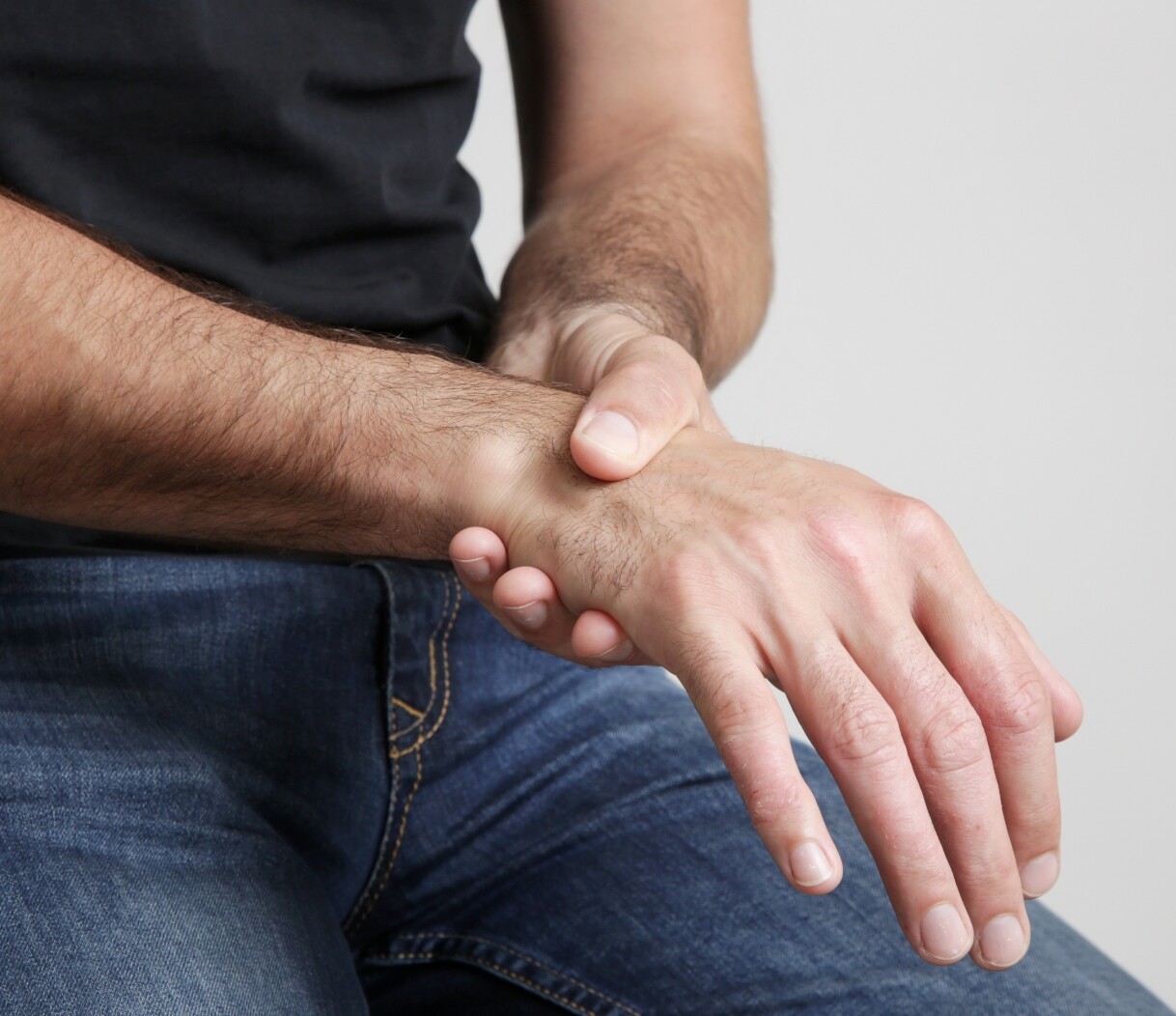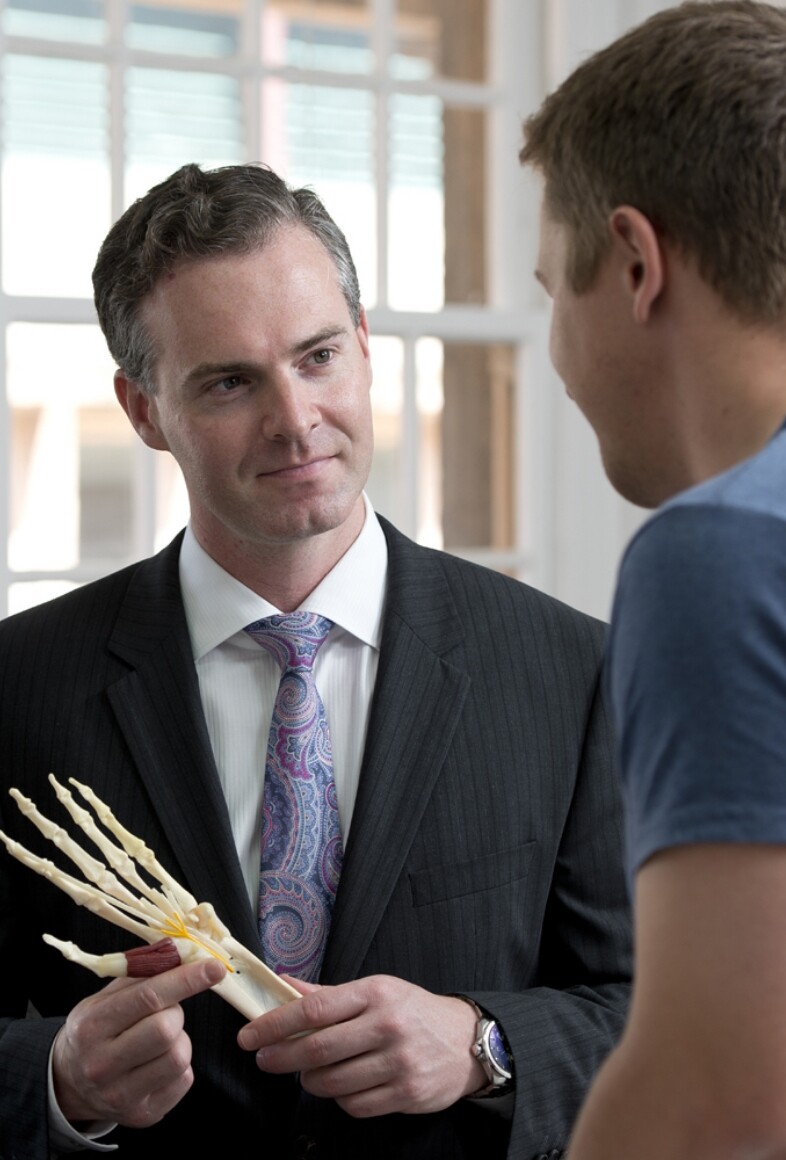Dupuytren's Contracture
Dr James McLean specialises in treating patients with locked-up fingers.
Dupuytren’s (pronounced du-pwe-tranz) contracture, also known as Viking's disease, is a slow-developing disorder that can result in deformity of the hand.
It affects the layer of tissue underneath the palm of the hand (the palmar fascia). The palmar fascia helps to anchor and stabilise the skin on the palm side of the hand. Dupuytren’s contracture causes a thickening and tightening of this fibrous tissue, eventually creating a thick cord that pulls fingers inward towards the palm.
The disorder typically affects the fourth and fifth fingers (the ring finger and little finger). Patients gradually experience a bending inward of these fingers, and eventually find themselves unable to fully straighten the digit.

Living with a Locked-up Finger
Dupuytren’s contracture can make everyday activities difficult, and can also inhibit a person’s ability to perform work duties.
Activities such as putting on clothes, shaking hands, grasping heavy objects, and typing can become a challenge. However, as the condition does not usually affect the thumb and index finger, many fine motor activities such as driving or writing can often still be performed.
The condition usually progresses slowly over a number of years and is not usually painful.
Symptoms
As Dupuytren’s contracture progresses over a number of years, symptoms differ depending on the disease’s stage.
The first sign of Dupuytren’s is usually a thickening in the palm’s skin. As the disease progresses, this skin may develop a puckered or dimpled appearance. Lumps or nodules also form under the skin of the palm, which is sensitive to the touch, but not usually painful.
Later stages of Dupuytren’s involve cords of tissues forming under the palm’s skin that extend to the fingers, causing them to pull in toward the palm. These finger contractures can occur in one or both hands, although one hand is more often more severely affected.
Causes of Dupuytren’s Contracture
The exact cause of this condition is unknown.
Unlike certain other ailments affecting the hand and wrist, such as trigger finger or carpal tunnel syndrome, there’s no evidence that Dupuytren’s is caused by hand trauma or overuse.
That being said, there are a number of risk factors that are believed to potentially contribute to Dupuytren’s contracture. These may include:
That being said, there are a number of risk factors that are believed to potentially contribute to Dupuytren’s contracture. These may include:
- Age – The condition most commonly occurs in people over 50 years of age.
- Gender – Men are more likely to develop Dupuytren’s, and to have more severe contractures than women.
- Ancestry – People of Northern European, Celtic, or Scandinavian descent are at higher risk of developing the disease.
- Heredity – Dupuytren’s contracture often runs in families.
- Medical conditions – People with diabetes or epilepsy show a higher incidence of the condition.
- Alcohol and tobacco use – Alcoholics and smokers are associated with a higher instance of Dupuytren’s.
Diagnosis
Due to its visible symptoms, diagnosis for this condition can be made after a physical examination and discussion about your symptoms and family history.
During your examination, Orthopaedic surgeon Dr James McLean may press different parts of your hands and fingers to assess the tissue beneath. In particular, Dr McLean will take note of:
- Hardened knots or tough bands of tissue
- The range of motion of your fingers and thumb
- Sensitivity in your hand, fingers and thumb
These measurements, along with photographs to document the appearance of your hand, will help determine the condition’s rate of progression over time.

Treatment Options for Dupuytren’s Contracture
Many instances of Dupuytren’s contracture can be managed through non-surgical methods.
For instance, corticosteroids may be injected into a problematic nodule to slow the progression of its contracture.
Also, a number of recent treatments, including calcium channel blockers, gamma interferon treatment, and percutaneous needle fasciotomy, show some promise in managing the disease, although no cure is currently known.
Xiaflex collagenase injections can be administered to break up cords in patients with primary central, isolated cords. Xiaflex is not currently covered by Medicare. Xiaflex is not indicated in patients with multiple or complex cords.
If Dupuytren’s progresses so that the hand is no longer functional, surgery is usually recommended to return the fingers to their normal range of movement. Depending on each individual case, techniques may include:
- Releasing the fascia bands via small incisions in the palm.
- Removing the thickened fascia to restore movement.
- Removing both the fascia and associated skin and repairing the palm with a skin graft.
Finger Release Surgery
Commonly, Dupuytren’s dematofasciectoym (removing the diseased tissue) is best achieved through open surgery.
Dr McLean is an Orthopaedic surgeon in Adelaide with a special interest in using minimally invasive methods wherever possible to reduce trauma and speed up recovery times after surgery.
Arthroscopy (also known as key-hole surgery) is used wherever appropriate due to its minimal risk of infection and short hospital stay for patients. Dr McLean will take a number of individual circumstances into account when recommending a treatment plan that offers the best likelihood of success along with the least disruption to your daily life.
How Dr James McLean can help
Dr James McLean provides consultation and various treatments for a wide variety of hand and wrist conditions in Adelaide.
With his extensive experience in treating upper limb conditions, he works with his patients to create tailored treatment plans which yield the best possible outcomes for their injuries.
Click here for more information on other conditions involving the shoulder, hand, wrist, and elbow which Dr James McLean has a special interest in treating.

